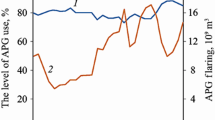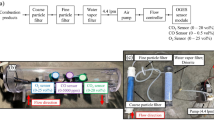Abstract
The results of an exploratory study of the effects of in situ crude oil spill burning on air quality in the Beaufort Sea region of the Arctic are presented. A scenario is postulated defining the amounts of oil released, the size and number of burnable oil pools, and the duration of the burning period. Estimates are made of the likely emissions of soot, CO, SO2 and metals based on literature and some experimental work. Assumptions are made about plume rise and dispersion which permit downwind concentrations of emissions to be calculated and compared with air quality objectives. Although the calculated concentrations may contain significant error because of the many assumptions, it is believed that the data demonstrate that concentrations of SO2 and CO will be acceptably low, concentrations of soot and metals will often be undesirably high within 10 km of the fires, but will be acceptably low at greater distances. It is concluded that burning may be a method of substantially reducing the adverse environmental impact of oil spills in the Arctic.
Similar content being viewed by others
References
Berry, M. O., Dutchak, P. M., Lalonde, M. E., McColloch, J. A. W., and Savdie, I.: 1975, ‘Weather, Waves and Icing in the Beaufort Sea’, Beaufort Sea Project, Technical ReportNo. 21, Environment Canada, Victoria, B.C.
Burns, B. M.: 1973, ‘The Climate of the Mackenzie Valley’ Vols. i and 2. Environment Canada Atmospheric Environment Service Climatological Studies No. 24.
Coupal, B.: 1976, ‘Report on Controlled Combustion Tests Carried out Near Rimouski’, Environment Canada Report EPS-4-EC-76-2.
Day, T., Mackay, D., Nadeau, S., and Thurier, R.: 1979, ‘Characteristics of Atmospheric Emissions From An in situ Crude Oil Fire’, Environment Canada Report. EPS-4-EC-79-1.
Department of Fisheries and Environment, Canada: 1976, Criteria for National Air Quality Objectives.
Department of Fisheries and Environment: 1975, National Air Pollution Surveillance, Report 1975, EPS 5-AP-76-16. Environment Canada.
Ledbetter, J. O.: 1972, Air Pollution: Part A Analysis, Marcel Dekker, Inc., New York.
Logan, W. J., Thornton, D. E., and Ross, S. L.: 1975, ‘Oil Spill Countermeasures for the Southern Beaufort Sea’, Beaufort Sea Project Technical Report 31a and 31b (Appendix). Environment Canada, Victoria, B.C. Also issued as Reports EPS-3-EC-77–6 and EPS-3-EC-77–7.
Milne, A.: 1975, ‘Offshore Drilling in the Beaufort Sea—A Preliminary Environmental Assessment’, Beaufort Sea Project Technical ReportNo. 39, Environment Canada, Victoria, B.C.
Munn, R. E., Tomalain, J., and Titus, R. L.: 1970, Atmosphere 8, 52.
Norcor Engineering and Research Ltd.: 1977, ‘Probable Behaviour and Fate of Winter Oil Spill in the Beaufort Sea’, Environment Canada Report No. EPS-4-EC-77-5.
Norcor Engineering and Research Ltd.: 1975, ‘The Interaction of Crude Oil with Arctic Sea Ice, Beaufort Sea Project Technical ReportNo. 27, Environment Canada, Victoria, B.C.
Pimlott, D., Brown, D., and Sam, K.: 1976, ‘Oil Under the Ice’, Canadian Arctic Resources Committee, Ottawa.
Portelli, R. V.: 1977a, ‘Data on Mixing Heights, Wind Speeds and Ventilation Coefficients for Canada’, Internal Report No. ARQT-4-76, Atmospheric Environment Service of Environment Canada.
Portelli, R. V.: 1977b, ‘User's Guide to Three Interactive Point Source Dispersion Models’, Personal Communication.
Ross, S. L., Logan, W. J., and Rowland, W.: 1977, ‘Oil Spill Countermeasures: The Beaufort Sea and the Search for Oil’, Environment Canada, Ottawa.
Seinfeld, J. H.: 1975, Air Pollution: Physical and Chemical Fundamentals, McGraw-Hill, New York.
Shaw, R. W., Hirt, M. S., and Tilley, M. A.: 1972, Atmosphere 10, 33.
Singer, I. A., Frizzola, J. A., and Smith, M. E.: 1964, APCA J. 14, (AP 23S16041).
Somers, E. V.: 1971, Dispersion of Pollutants Emitted into the Atmosphere, Air Pollution Control, Part I, Editor, Werner Strauss, Wiley-Interscience, New York.
Turner, D. B.: 1974, Workbook of Atmospheric Dispersion Estimates, USEPA Air Programs Pub. No. AP-26.
Walker, E. P.: 1975, ‘Oil, Ice and Climate in the Beaufort Sea’, Beaufort Sea Project Technical ReportNo. 35, Environment Canada, Victoria, B. C.
Author information
Authors and Affiliations
Additional information
To whom correspondence should be addressed.
Rights and permissions
About this article
Cite this article
Day, T., Mackay, D., Nadeau, S. et al. Emissions from in situ burning of crude oil in the arctic. Water Air Soil Pollut 11, 139–152 (1979). https://doi.org/10.1007/BF00286625
Received:
Revised:
Issue Date:
DOI: https://doi.org/10.1007/BF00286625




